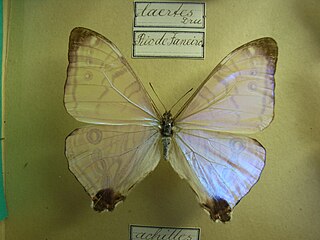
The morpho butterflies comprise many species of Neotropical butterfly under the genus Morpho. This genus includes more than 29 accepted species and 147 accepted subspecies, found mostly in South America, Mexico, and Central America. Morpho wingspans range from 7.5 cm (3.0 in) for M. rhodopteron to 20 cm (7.9 in) for M. hecuba, the imposing sunset morpho. The name morpho, meaning "changed" or "modified", is also an epithet. Blue morphos are severely threatened by the deforestation of tropical forests and habitat fragmentation. Humans provide a direct threat to this spectacular creature because their beauty attracts artists and collectors from all over the globe who wish to capture and display them. Aside from humans, birds like the jacamar and flycatcher are the adult butterfly’s natural predators.

Morpho achilles, the Achilles morpho, blue-banded morpho, or banded blue morpho, is a Neotropical butterfly.

Morpho helenor, the Helenor blue morpho or common blue morpho, is a Neotropical butterfly found throughout Central and South America from Mexico to Argentina. It is a species group that may or may not be several species. Many subspecies have been described.

Morpho deidamia, the Deidamia morpho, is a Neotropical butterfly. It is found in Panama, Nicaragua, Costa Rica, Suriname, Bolivia, Venezuela, Colombia, Peru, Ecuador, and Brazil. It is a species group, which may be, or may not be several species. Many subspecies have been described.

Morpho aega, the Aega morpho, is a Neotropical butterfly found in Paraguay, Argentina and Brazil.

Morpho aurora, the Aurora morpho, is a Neotropical butterfly found in Bolivia and Peru.

Morpho theseus, the Theseus morpho, is a Neotropical butterfly. It is found in Panama, Costa Rica, Mexico, Colombia, Peru, Ecuador, Venezuela, Honduras and Guatemala.

Morpho portis is a Neotropical butterfly. It is found in Brazil, Uruguay, Venezuela, Colombia, Peru, and Paraguay. Several subspecies and many forms have been described. The larvae feed on Gramineae.

Morpho adonis, the Adonis morpho, is a Neotropical butterfly. It is found in Venezuela, Suriname, French Guiana, Colombia, Ecuador, Brazil, and Peru. The wingspan ranges from 70 to 90 millimetres.

Morpho cypris, the Cypris morpho, is a Neotropical butterfly. It is found in Panama, Costa Rica, Nicaragua, Colombia, Venezuela, Trinidad and Tobago and Ecuador. Several subspecies and many forms have been described.

Morpho rhetenor, the Rhetenor blue morpho, is a Neotropical butterfly of the family Nymphalidae. It is found in Suriname, French Guiana, Brazil, Peru, Ecuador, Colombia, and Venezuela.

Morpho richardus, or Richard's morpho, is a Neotropical butterfly found only in Minas Gerais, Brazil.

Morpho cisseis, the Cisseis morpho, is a large Neotropical butterfly found in the southern and western Amazon in Bolivia, Colombia, Peru, Ecuador, and Brazil. It includes several subspecies, but has itself sometimes been treated as a subspecies of the sunset morpho. Both are highly valued by collectors.

Morpho anaxibia, the Anaxibia morpho, is a species of Neotropical butterfly endemic to Brazil.

Morpho lympharis, the Lympharis morpho, is a Neotropical butterfly found in Peru and Bolivia.

Morpho laertes, the White morpho or Epistrophus white morpho, is a Neotropical butterfly found in Brazil, Uruguay, Paraguay, and Argentina. The white morpho is native to the Atlantic Forest, where they are distributed throughout a landscape of multiple species.
Morpho absoloni is a Neotropical butterfly.

Morpho telemachus is a Neotropical butterfly.
Morpho uraneis is a Neotropical butterfly. It is found in Brazil and Ecuador.
Morpho niepelti is a Neotropical butterfly.
















